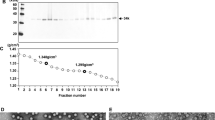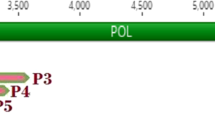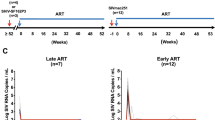Abstract
Because of the growing incidence of AIDS (acquired immune deficiency syndrome), the need for studies on animal models is urgent. Infection of chimpanzees with the retroviral agent of human AIDS, the human immunodeficiency virus (HIV), will have only limited usefulness because chimpanzees are in short supply and do not develop the disease. Among non-human primates, both type D retroviruses and lentiviruses can be responsible for immune deficiencies. The D-type retroviruses1–3, although important pathogens in macaque monkey colonies, are not satisfactory as a model because they differ in genetic structure and pathophysiologi-cal properties from the human AIDS viruses4,5. The simian len-tivirus, previously referred to as simian T-cell lymphotropic virus type III (STLV-III), now termed simian immunodeficiency virus (SIV) is related to HIV by the antigenicity of its proteins and in its main biological properties, such as cytopathic effect and tropism for CD4-bearing cells6–9. Most importantly, SIV induces a disease with remarkable similarity to human AIDS in the common rhesus macaques, which therefore constitute the best animal model currently available10. Natural or experimental infection of other monkeys such as African green monkeys or sooty mangabeys has not yet been associated with disease8,9,11. Molecular approaches of the SIV system will be needed for biological studies and development of vaccines that could be tested in animals. We have cloned and sequenced the complete genome of SIV isolated from a naturally infected macaque that died of AIDS. This SIVMAC appears genetically close to the agent of AIDS in West Africa, HIV-2 (ref. 12), but the divergence of the sequences of SIV and HIV-2 is greater than that previously observed between HIV-1 isolates13.
This is a preview of subscription content, access via your institution
Access options
Subscribe to this journal
Receive 51 print issues and online access
$199.00 per year
only $3.90 per issue
Buy this article
- Purchase on Springer Link
- Instant access to full article PDF
Prices may be subject to local taxes which are calculated during checkout
Similar content being viewed by others
References
1. Daniel, M. D. et al Science 223, 602–605 (1984). 2. Marx, P. A. et al. Science 223, 1083–1086 (1984). 3. Stromberg, K. et al. Science 224, 289–292 (1984). 4. Sonigo, P., Barker, C., Hunter, E. & Wain–Hobson, S. Cell 45, 375–385 (1986). 5. Power, M. D. et al. Science 231, 1567 (1986). 6. Daniel, M. D. et al. Science 228, 1201–1204 (1985). 7. Kanki, P. J., Alroy, J. & Essex, M. Science 230, 951–954 (1985). 8. Fultz, P. N. et al. Proc. natn. Acad. Sci. U.S.A. 83, 5286–5290 (1986). 9. Murphey–Corb, M. et al. Nature 321, 435–437 (1986). 10. Letvin, N. L. et al. Science 230, 71–73 (1985). 11. Kanki, P. S. et al. Lancet i, 1330–1332 (1985). 12. Guyader, M. et al. Nature 326, 662–669 (1987). 13. AHzon, M., Wain–Hobson, S., Montagnier, L. & Sonigo, P. Cell 46, 63–74 (1986). 14. Clavel, F. et al. Nature 324, 691–695 (1986). 15. Chalifoux, L. V. et al. Lab. Invest. 55, 43–50 (1986). 16. Sonigo, P. et al. Cell 42, 369–382 (1985). 17. Wain–Hobson, S., Sonigo, P., Danos, O., Cole, S. & Alizon, M. Cell 40, 9–17 (1985). 18. Hirsch, V. et al Proc. natn. Acad. Sci. U.S.A. 83, 9754–9758 (1986). 19. Kornfeld, H., Riedel, N., Viglianti, G. A., Hirsch, V. & Mullins, J. I. Nature 326, 610–613 (1987). 20. Desrosiers, R. C., Daniel, M. D., Letvin, N. L., King, N. W. & Hunt, R. D. Nature 327, 107 (1987). 21. Kanki, P. J. et al Science 228, 1199–1201 (1985). 22. .Kanki, P. J. et al Science 232, 238–843 (1986). 23. . Benveniste. R E. et al J. Virol 60, 483–490 (1986). 24. Perez, L. G., Davis, G. L. & Hunter, E. / Virol (in the press). 25. Davis, J. L., Molineaux, S. & Clements, J. E. / Virol 61, 1325–1331 (1987). 26. Brun–Vezinet, F. et al Lancet ii, 128–132 (1987). 27. Clavel, F. et al Science 233, 343–346 (1986). 28. Zarling, J. M. et al. Nature 323, 344–346 (1986). 29. Putney, S. D. et al Science 234, 1392–1395 (1986). 30. Lasky, L. et al Science 233, 209–212 (1986). 31. Wilbur, W. J. & Lipman, D. J. Proc. natn. Acad. Sci. U.S.A. 80, 726–730 (1983). 32. Kawakami, T. et al. Virology 156, 853–869 (1987). 33. Seiki, M., Hattori, S., Hiriyama, Y. & Yoshida, M. Proc. natn. Acad. Sci. U.S.A. 80,3618–3622(1983). 34. Schwartz, D. E., Tizard, R. & Gilbert, W. Cell 32, 853–869 (1983). 35. Nabel, G. & Baltimore, D. Nature 326, 711–713 (1987).
Author information
Authors and Affiliations
Rights and permissions
About this article
Cite this article
Chakrabarti, L., Guyader, M., Alizon, M. et al. Sequence of simian immunodeficiency virus from macaque and its relationship to other human and simian retroviruses. Nature 328, 543–547 (1987). https://doi.org/10.1038/328543a0
Received:
Accepted:
Issue Date:
DOI: https://doi.org/10.1038/328543a0
This article is cited by
-
In vitro inhibitory effect of maraviroc on the association of the simian immunodeficiency virus envelope glycoprotein with CCR5
Virus Genes (2021)
-
F99 is Critical for Dimerization and Activation of South African HIV-1 Subtype C Protease
The Protein Journal (2013)
-
A reflection on HIV/AIDS research after 25 years
Retrovirology (2006)
-
Genetic complementation between replication-defective mutants of HIV-1 and SIVagm
Archives of Virology (1996)
Comments
By submitting a comment you agree to abide by our Terms and Community Guidelines. If you find something abusive or that does not comply with our terms or guidelines please flag it as inappropriate.



